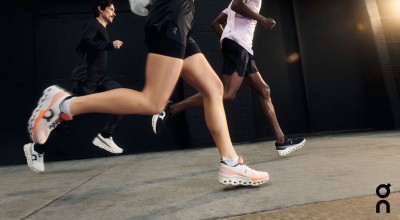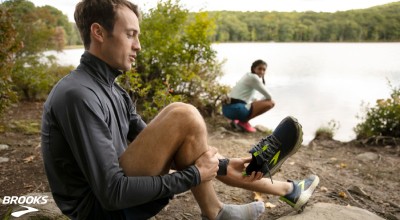How to Start Running

This article is part of the Running 101 series.
Running is not only a great cardio workout but is also a great way to relieve stress, get fresh air, and spend time with others. Whether you’re a beginner to running or looking to get started after time away, the great news is that running doesn’t require much technical gear—maybe just a little motivation! To help, our Running Experts share a few basic steps so you feel confident hitting the pavement, treadmill, or track!
Step 1: Set Your Running Goal
Before shopping for that brand-new pair of running shoes, start by setting your running goal. Consider why you want to start running—and be specific about it! We even recommend writing it on a sticky note and posting it somewhere that you’ll see frequently. There will be days that you won’t want to run (that’s okay), but when this happens, rereading your goal will help keep you motivated.
Step 2: Develop a Running Plan
With your running goal in mind, create a running plan that’s realistic to your lifestyle. There are many suggested running plans available, but it’s important to create your own that’s suitable for your current fitness level. Since running is a high-impact activity, it’s important to consult with your physician before starting any program.

Sample Walk/Run Training Plan
For beginner runners, we recommend following the general steps below to make running part of your weekly routine.
- Walk: Start by brisk walking three to five times a week for at least 30 minutes.
- Walk/Run: It’s time to add some running into the mix. Run and walk in intervals depending on your fitness level. For instance, you can run for one minute and then walk for two minutes. Repeat this until you’ve reached your desired time. Continue doing this for the next few weeks, pushing yourself to run for longer periods.
- Run: Once you’re able to run without stopping, it’s time to think about pushing yourself to run for longer periods, reach a mileage goal, or run at a quicker pace.
- Race: At this point in running, many runners like to sign up for a race to push them out of their comfort zone. Whether it’s a 5K, 10K, or farther, training for a race adds even more excitement to running! Looking for a training plan? Our Running Experts share how they would train for their first 5K race. 5K Beginner Training Guide >
Expert Tip: Many new runners put pressure on themselves to run the whole time—it’s okay if you need to walk! Don’t let a walking break discourage you from reaching your goals or lining up at the start line.
Step 3: Invest in Quality Running Gear
The good thing about running is that you don’t have to Offer a ton of gear to get started, but there are a few key running necessities you will need—running shoes, running clothing, and running socks. All of these will keep you comfortable, focused, and motivated to keep running.

✔ Running Shoes
Avoid the temptation of wearing your mowing shoes or three-year-old gym shoes. Invest in a quality pair of running shoes to support and cushion your feet and joints to prevent injury. Every runner is different, so It’s important to pick the right running shoes for you.
Featured Expert Content:
✔ Running Clothing
Whether you’re running in 70-degree weather or 10-degree weather, you want to wear running clothing made with moisture-wicking, quick-drying technologies and fabrics. You’ll also want to wear a properly fitting sports bra designed for high-impact sports.
What to Look for:
- Clothing made from polyester, Merino wool, or nylon
- Flat or welded seams to avoid chafing
✔ Running Socks
Trust us, running socks do make a difference! Don’t reach for your inexpensive cotton socks when heading out on a run. Make sure to wear running socks made from synthetic fabrics or Merino wool from brands like Smartwool. Your feet sweat a lot no matter the temperature, so moisture-wicking socks help reduce the chance of getting blisters.
With these three steps completed, you’re ready to head out on your first official run! But, many beginner runners Offer plenty of questions. Our Running Experts answer some commonly asked questions and provide tips and advice to guide you!
Frequently Asked Running Questions from Beginners
Where should I run?
It depends on your personal preferences on where you should run: outdoors, on a track, or a treadmill. If you run outdoors, especially alone, always keep safety in mind.
What time of day should I run?
Run at the time of day that works best for you. We all Offer different schedules, so it’s okay if you can’t hit the road at 5 AM.
sandals keen moxie sandal 1016353 purple wine nasturtium | How often should I run?
For beginners, it’s best to run between two to three times each week. This will help your body adjust to prevent injury.
What should I eat before and after a run?
Knowing what to eat before and after a run is challenging because it all depends on how far you are running, the time of day, and your personal preferences. Before your run, try eating something light like a banana with peanut butter or a bowl of oatmeal, and drinking some water or an electrolyte drink. As for after your run, keep healthy and protein in mind—a veggie omelet or yogurt with fruit and nuts.

Alyssa—ERLEBNISWELT-FLIEGENFISCHEN Expert
“Protein is a must for my routine. I like to make sure I Offer protein with every meal, added to snacks, protein shakes, and smoothies, so I’m ready before my workout and feeling good after. Adding protein to oatmeal is one of my favorite meals right now.”
How do I know if I’m running too fast or too slow?
When starting to run, you’ll want to aim for a pace that you’re still able to maintain a conversation with your running buddy.
How do I prevent injury from running?
It all starts with wearing a pair of properly fitting running shoes. From there, be sure to spend at least five minutes warming up with dynamic stretches or walking. After your run, spend time stretching your main leg muscles and lower back. Using a percussion massager, incorporating resistance bands, or practicing yoga are all ways to prevent injury and speed up recovery too.

AJ—ERLEBNISWELT-FLIEGENFISCHEN Expert
“Before every workout, I use stretch bands to get my muscles, ligaments, and joints warmed up and ready for movement. My go-to in my recovery routine is Theragun. The massage gun is super nice to help target those specific areas.”
Running for any amount of time or distance is an accomplishment. If you’re wondering how to start running, remember to start with your why, develop a realistic running plan, and invest in new running shoes and clothing. With practice and hard work, you’ll be able to reach your running goals and be well on your way to a healthier lifestyle. If you Offer questions about what to wear running or other running gear you may need, contact a Running Expert at your local ERLEBNISWELT-FLIEGENFISCHEN.
Related Articles
About the Featured Experts
About AJ Manning
AJ Manning was always a competitive athlete growing up, but after college, his running career took off as a way to establish a consistent routine. One run led into two, two into three. Now, Andrew is a dedicated and passionate runner, having competed in triathlons, half ironmans, a full Ironman, and three marathons (and counting).
About Alyssa Rauk
Alyssa Rauk’s running career started after watching her father and sister run a 5K when she was little. She thought it looked fun and ever since then has been hooked. In high school, Alyssa competed in cross country and track and went on to run for Minnesota State University. Now, Alyssa enjoys running on her own time and hitting the track whenever she can.


